The Role of Assistive Devices in Preventing Falls at Home
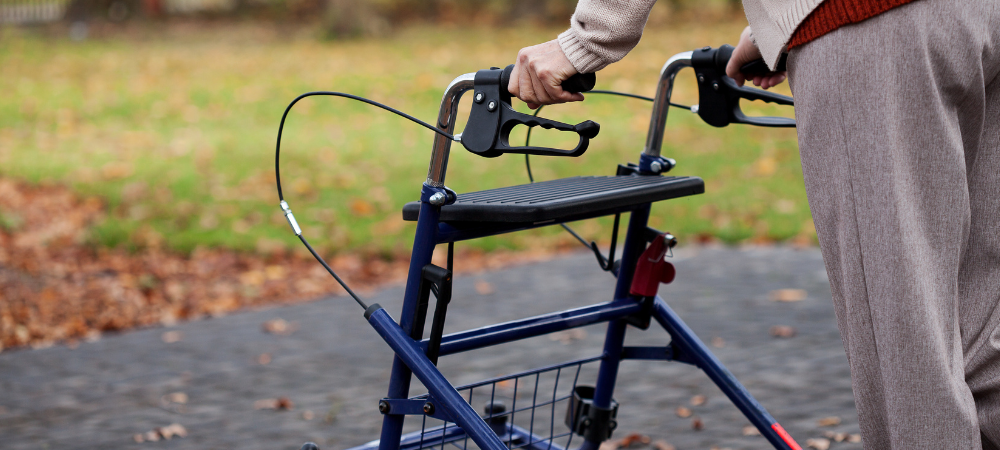
As we age, a number of factors can make falls more likely. These include decreased mobility, reduced balance, visual changes, chronic illness, medications and other health challenges. Falls are the leading cause of injury for people over the age of 65. Studies show that 90% of hip fractures are caused by falls and 40% of long-term care admissions are due to falls or related injuries. In fact, falls can cause a significant decrease in quality of life and are one of the main reasons why older adults lose their independence.
Although the risk does increase with age, falls should not be considered an inevitable part of aging. Luckily, by taking the right actions and precautions, the majority of falls can be prevented. Assistive devices are one way older adults can reduce their risk of falling and feel more confident living independently at home. A physical or occupational therapist should always assess your needs and show you how to use an assistive device safely, but here’s some general information to help guide you.
What are Assistive Devices?
An assistive device is a tool or technology that can help an older adult or a person living with a disability complete a task that would otherwise be unsafe or difficult. Examples include: wheelchairs, ramps, walkers, medication dispensers, grab bars, hearing aids, prosthetics and more. This article focuses specifically on the assistive devices that may help to reduce the likelihood of a fall.
There is a lot of fall prevention equipment available. Some commonly recommended options are included below. This information is meant to provide some general guidance. A health professional can help you find the right devices for your unique needs.
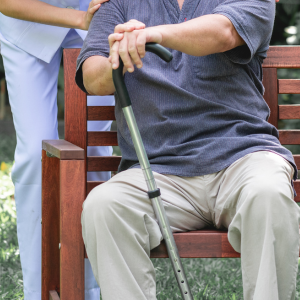
Senior man sits on bench holding cane while speaking with nurse
Canes
A cane provides an additional point of contact with the floor for extra stability by increasing the base of support. A cane can also relieve leg strain. These devices are adjustable, relatively affordable, portable and available in several styles:
-
- Straight Canes: Also known as a walking stick, this cane has a straight shaft and a single one-point base. They offer some additional stability and allow you to unload weight from the ‘weaker’ side of the body.
- Offset Canes: This cane’s bent shaft and offset handle creates more balance and stability than a straight cane. This cane assists by directing your weight over the cane shaft which increases stability and offsets pressure from the wrist.
- Four-Point (or Quad) Canes: Similar to a straight cane, the quad option has four feet extending at the bottom. This creates a wider base and allows for even more stability, which is beneficial when one side of the body is particularly weak. This device is helpful for navigating stairs and stays upright so you don’t have to bend down to pick it up.
- Three-Point Canes: A tripod cane is similar to a quad, but has three legs on a triangular base. It is great on uneven indoor or outdoor surfaces including tile, grass and trails.
- Seat Canes: Also called a walking cane chair, this is a sturdy support cane when closed and a comfortable seat to rest on when open. These canes are great for travel, line ups and for a break during longer walks.
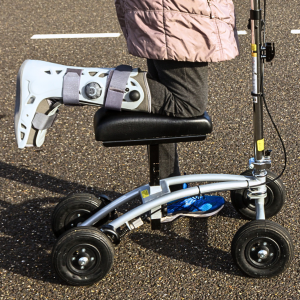
Women using knee walker
Walkers
For those with more significant balance and stability issues, poor endurance, respiratory issues or other challenges like arthritis or leg weakness, a therapist may suggest a walker. Walkers have a wide base of support and can carry more body weight than a cane. There are different types of walkers available depending on your needs:
-
- Standard: Also called a pickup walker, standard models have four rubber-tipped legs, no wheels and are meant for indoor use. Some models are portable and can be easily folded. Standard walkers can hold a lot of weight and are used when you’re either not allowed or able to fully weight bear on your legs. This provides the most stability, but you have to lift the walker to move. This can be limiting for individuals with a weak upper body. Please note that if you are unsteady on your feet, this model is not right for you.
- Two-Wheeled: These walkers have two wheels on the front legs and rubber-tips on the two back legs. This type can help bear your weight as you move and allows for a smoother and faster walking pattern. These are a good option if lifting a standard walker is too difficult.
- Rollator: Four-wheeled walkers provide continued support but are less stable than a standard walker because they move freely on their wheels. You should not use this model if you need to bear heavy weight on the device. Also, rollators use hand brakes to control movement, so fine motor skills are required to safely operate. These models have baskets for keeping personal items and a seat for resting if endurance is a concern. Always make sure that the brakes are on before taking a seat.
- Knee Walker: Also called a platform walker, these are generally used for short periods of time. They are recommended for individuals who are recovering from a below the knee injury or surgery, which requires the foot and/or leg to be non-weight bearing during recovery. They can be used as an alternative to crutches. Knee walkers have four wheels, a handle and a platform to rest your injured leg. To move, you push the walker with your steady leg.
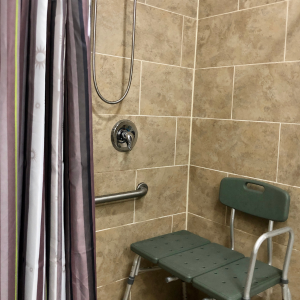
Shower with assistive features like chair and grab bars
Bath and Shower Equipment
Bathrooms can create a lot of risks for older adults with mobility issues if appropriate falls prevention equipment is not used. Slippery floors in bathing areas and getting in or out of the bath or shower can easily lead to falls and injury. There are a number of assistive devices available to improve the safety of your bathroom:
-
- Shower Chair: Sitting on a chair while you shower is inevitably a safer option than standing. Bath chairs have holes for water drainage and suction cup feet to safely secure them in the tub or shower. They also come with or without back supports and armrests for added support when standing up from the chair.
- Bath Board: This wooden or plastic board spans across the bath and is usually held in place by adjustable rubber stops. This device can provide a place to sit during bathing tasks and allow you to step in and out of the bath from a seated position.
- Bath Lifts: This is a mechanical powered device that is installed within the bathtub. It provides a seat that can be lowered and raised so you can get in and out of the bath safely.
- Tub Clamp Bar: This device can be attached to a bathtub as a handle to hold onto for additional support and stability when stepping in and out of a bathtub.
- Bathroom Rails: Grab bars should be installed throughout the bathroom area to provide stability when moving in and out of the room and to help you stand safely in the shower or get up from a seated position. The number of bars and appropriate length will be based on a healthcare provider’s assessment of your specific needs and the home environment.
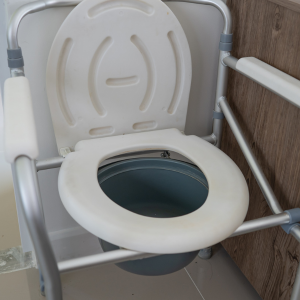
Commode or portable toilet
Toilet Accessories
Getting on and off the toilet can be challenging for seniors who are experiencing mobility issues, reduced strength in their upper and lower body or general pain. Adding some of the equipment below can improve the safety of toileting activities:
-
- Raised toilet seat: Adding a raised toilet seat to the top of your existing toilet seat makes it easier to sit and stand. Elevated seats come in different heights. The specific seat height will be recommended by your healthcare provider based on your mobility assessment results.
- Safety Frame: A metal frame attachment adds armrests to your toilet to give you a place to grip as you sit down and then stand up. There are some models that combine the armrests and raised toilet seat as one piece of equipment. Connect with your healthcare provider to determine the best option for you.
- Commode: These portable and height-adjustable toilets can be helpful if the bathroom is far from the bedroom, on another level of the house, or to prevent falls during nighttime bathroom breaks. They can also be used during recovery from surgery or an injury. Commodes can also be wheeled if you need assistance getting to the bathroom.
- Grab Bars: Grab bars can also be added around the toilet to provide assistance when sitting and standing. The number of bars and bar length required will be based on a healthcare provider’s assessment of your needs and specific home environment.
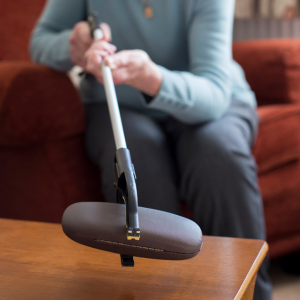
Senior women using reacher arm to get glasses case
Reachers
Reachers, also known as grabbers, are a simple tool that act as an extension of your arm to grab objects that are out of reach. They can help you move lightweight items from high shelves instead of using a ladder or step stool. Reachers can also prevent dizziness or light-headedness that can sometimes occur when bending over. There are different models available that vary in weight capacity and portability and some also include magnets to pick up small, metal objects.
These assistive devices, and many others, are available at hardware stores, pharmacies, medical equipment stores and other online speciality outlets. Along with hazard proofing your home, they can make daily activities safer, easier and significantly reduce your fall risk. Some solutions are easy to install and relatively inexpensive while others may require professional help or a larger investment.
If you are worried about falls prevention strategies and home safety, an occupational therapist may be able to help. A therapist can more thoroughly review your home for hazards and suggest practical changes and other adaptive devices to make everyday activities safer. For further information on how occupational therapists can provide guidance on assistive devices, please visit the College of Occupational Therapy of Ontario: https://www.coto.org/
Reviewed By: Banu Sundaralingam, Occupational Therapist, Professional Practice Specialist and Educator
